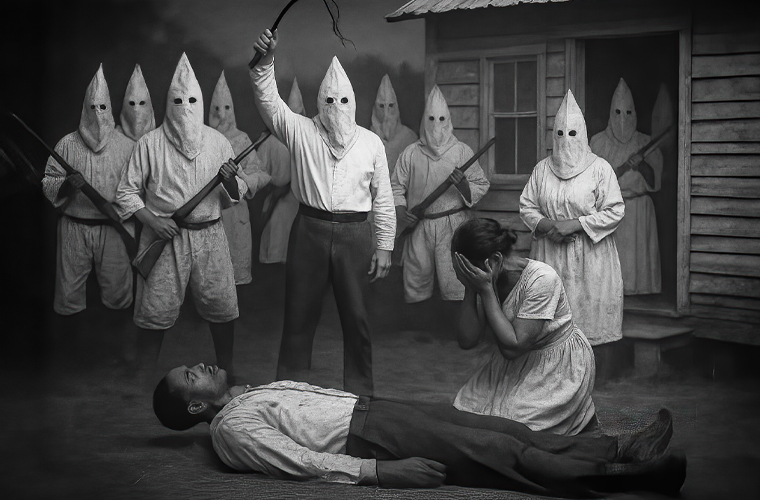On October 9, 1893, in the rural expanse of Weakley County, Tennessee, near the small town of Dresden, a Black farmer named Bob Hudson became one of countless victims of the era’s unchecked racial terror. Hudson, a hardworking man supporting his family in the post-Reconstruction South, found himself thrust into a nightmare of vigilante violence after his wife dared to seek justice through the legal system—a system notoriously rigged against Black Americans. Reports from the time detail how Mrs. Hudson had filed charges of assault and battery against a white man who had attacked her.
The perpetrator was briefly arrested and slapped with a minor fine, a rare instance of any accountability for white-on-Black violence. But this fleeting nod to the law ignited a furious backlash from a group known as the Whitecaps. This secretive vigilante organization terrorized Black communities across the South under the guise of moral enforcement. In a brazen act of retaliation, ten masked Whitecaps stormed the Hudsons’ modest home under the cover of night, dragging Mrs. Hudson from her bed and subjecting her to a brutal whipping that left her severely injured and traumatized. As her husband rushed to protect her, the mob turned their fury on him, shooting him dead in cold blood right there on his own property. No arrests were made, no trials held; the killers melted back into the white community, shielded by the complicity of local authorities and the pervasive culture of white supremacy.
This horrific episode was far from an isolated incident but a stark illustration of the systemic racial terrorism that defined the United States in the late 19th and early 20th centuries. The Jim Crow era, which solidified after the withdrawal of federal troops from the South in 1877, unleashed a wave of extralegal violence designed to enforce racial hierarchy and suppress Black advancement. White mobs, often operating with the tacit approval—or outright participation—of law enforcement, used lynching as a tool of intimidation, spectacle, and control. In Hudson’s case, the violence was a direct punishment for his wife’s audacity in challenging a white assailant, underscoring how the mere act of Black self-assertion could provoke lethal reprisals.
At the heart of this terror lay a grotesque double standard rooted in myths of racial purity and hypersexualized fears. White men routinely committed sexual violence against Black women with near-total impunity, viewing them as property to be exploited amid the lingering shadows of slavery. Historical accounts abound with stories of Black women enduring rape, assault, and coercion, yet perpetrators faced little to no consequences—arrests were rare, convictions rarer still, and punishments almost nonexistent. Conversely, the flimsiest whispers of “improper contact” between a Black man and a white woman could unleash mob fury. Fabricated accusations of rape or even casual interaction served as pretexts for lynchings, fueling a national panic that justified murder without evidence or due process.
According to exhaustive research by the Equal Justice Initiative (EJI), nearly one in four Black men lynched in the South between 1877 and 1945—approximately 25%—were falsely accused of sexual misconduct with white women. This statistic reveals how these killings were less about protection and more about preserving power. This asymmetry extended beyond sexual violence to lynchings themselves: white perpetrators evaded justice almost entirely, with fewer than 1% of documented cases resulting in convictions, even as crowds sometimes numbered in the thousands and turned the atrocities into public festivals complete with postcards and souvenirs.
Weakley County, like so many rural Southern locales, bore heavy scars from this reign of terror. Including Bob Hudson, at least six African Americans fell victim to racial terror lynchings there between 1877 and 1950, their lives extinguished in acts of unimaginable cruelty that echoed across generations. These killings were not random but deliberate enforcements of segregation, economic subjugation, and social dominance, often triggered by disputes over land, labor, or perceived slights. Today, communities in Weakley County are reckoning with this past through initiatives like the local Reconciliation Project, which honors the victims and educates residents on the enduring legacies of racial injustice.
Nationally, the scale of this horror is staggering: over 6,500 Black women, men, and children were victims of racial terror lynchings in the United States between 1865 and 1950, a conservative estimate that likely undercounts the true toll due to incomplete records and suppressed reporting. These were not mere crimes but state-sanctioned spectacles of dehumanization, leaving indelible wounds on Black families and American democracy alike. To delve deeper into these stories, explore the Equal Justice Initiative’s comprehensive reports and interactive maps, which illuminate the human cost of this dark chapter and urge ongoing efforts toward truth, reconciliation, and repair.

